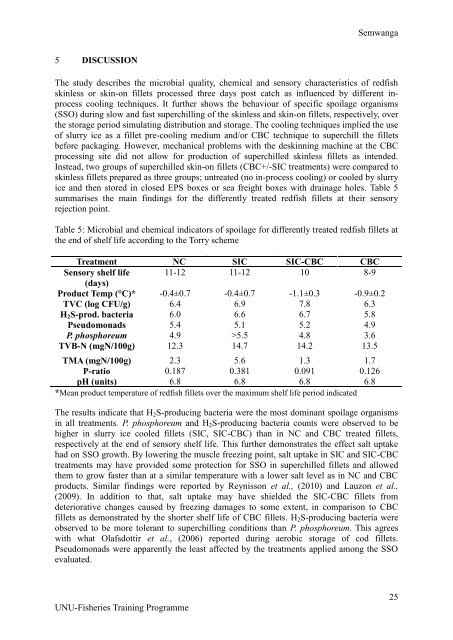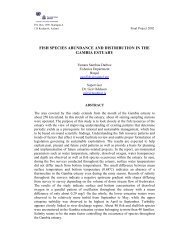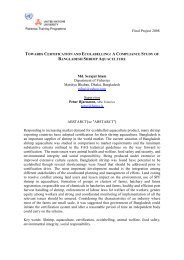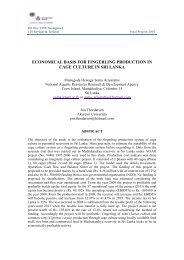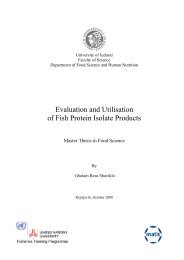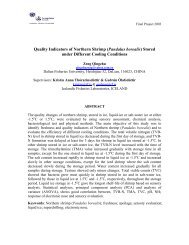THE EFFECT OF DIFFERENT COOLING TECHNIQUES ON THE ...
THE EFFECT OF DIFFERENT COOLING TECHNIQUES ON THE ...
THE EFFECT OF DIFFERENT COOLING TECHNIQUES ON THE ...
Create successful ePaper yourself
Turn your PDF publications into a flip-book with our unique Google optimized e-Paper software.
Semwanga5DISCUSSI<strong>ON</strong>The study describes the microbial quality, chemical and sensory characteristics of redfishskinless or skin-on fillets processed three days post catch as influenced by different inprocesscooling techniques. It further shows the behaviour of specific spoilage organisms(SSO) during slow and fast superchilling of the skinless and skin-on fillets, respectively, overthe storage period simulating distribution and storage. The cooling techniques implied the useof slurry ice as a fillet pre-cooling medium and/or CBC technique to superchill the filletsbefore packaging. However, mechanical problems with the deskinning machine at the CBCprocessing site did not allow for production of superchilled skinless fillets as intended.Instead, two groups of superchilled skin-on fillets (CBC+/-SIC treatments) were compared toskinless fillets prepared as three groups; untreated (no in-process cooling) or cooled by slurryice and then stored in closed EPS boxes or sea freight boxes with drainage holes. Table 5summarises the main findings for the differently treated redfish fillets at their sensoryrejection point.Table 5: Microbial and chemical indicators of spoilage for differently treated redfish fillets atthe end of shelf life according to the Torry schemeTreatment NC SIC SIC-CBC CBCSensory shelf life 11-12 11-12 10 8-9(days)Product Temp (°C)* -0.4±0.7 -0.4±0.7 -1.1±0.3 -0.9±0.2TVC (log CFU/g) 6.4 6.9 7.8 6.3H 2 S-prod. bacteria 6.0 6.6 6.7 5.8Pseudomonads 5.4 5.1 5.2 4.9P. phosphoreum 4.9 >5.5 4.8 3.6TVB-N (mgN/100g) 12.3 14.7 14.2 13.5TMA (mgN/100g) 2.3 5.6 1.3 1.7P-ratio 0.187 0.381 0.091 0.126pH (units) 6.8 6.8 6.8 6.8*Mean product temperature of redfish fillets over the maximum shelf life period indicatedThe results indicate that H 2 S-producing bacteria were the most dominant spoilage organismsin all treatments. P. phosphoreum and H 2 S-producing bacteria counts were observed to behigher in slurry ice cooled fillets (SIC, SIC-CBC) than in NC and CBC treated fillets,respectively at the end of sensory shelf life. This further demonstrates the effect salt uptakehad on SSO growth. By lowering the muscle freezing point, salt uptake in SIC and SIC-CBCtreatments may have provided some protection for SSO in superchilled fillets and allowedthem to grow faster than at a similar temperature with a lower salt level as in NC and CBCproducts. Similar findings were reported by Reynisson et al., (2010) and Lauzon et al.,(2009). In addition to that, salt uptake may have shielded the SIC-CBC fillets fromdeteriorative changes caused by freezing damages to some extent, in comparison to CBCfillets as demonstrated by the shorter shelf life of CBC fillets. H 2 S-producing bacteria wereobserved to be more tolerant to superchilling conditions than P. phosphoreum. This agreeswith what Olafsdottir et al., (2006) reported during aerobic storage of cod fillets.Pseudomonads were apparently the least affected by the treatments applied among the SSOevaluated.UNU-Fisheries Training Programme25


